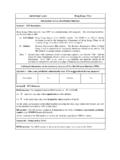Transcription of Hong Kong Welfare Model - welfareasia.org
1 1 hong kong 's Welfare Model Reconsidered - What Model ? What Traits? And What Functions? Linda Wong City University of hong kong Abstract From a liberal standpoint, hong kong 's Welfare Model is often seen as an embarrassment. On the other hand, conservatives hail it as a vindication of hong kong 's free market system. Little consensus is reached on what the Model actually is, the features that are unique to it and what functions it fulfills for society. The paper is an attempt to examine these issues. It is argued that after many decades of incremental improvements, hong kong has developed its special Welfare approach that differs from the classic residual paradigm and the East Asian Welfare Model .
2 Neither does it rely so heavily on the use of social security as the main instrument of social protection that is characteristic of Welfare systems in industrial economies. The extant system represents a complex mix of residual strands as well as principles of universalism and social equity. Under this system, all social classes benefit, albeit to varying extents. By the standards of advanced Welfare states, of course, benefits are not generous but neither are they niggardly. In terms of service delivery, both civil society and the state are key players. In particular, the state plays a bigger role than is commonly conceded.
3 It is also found that the system exhibits considerable stability and effectiveness, which can be attributed to the distribution template that cuts across class lines. Nevertheless the system faces key challenges that demand redress and responses to new problems. Key Words: Welfare Model , hong kong social Welfare Model , uniqueness and functions 2 Social Welfare Reconsidered in hong kong What Paradigm? Social policy researchers and social workers in hong kong are often embarrassed about the local Welfare system. The system, in their view, is too residual in character and lags behind the territory s advanced economy. Critics highlight the absence of pensions, unemployment benefits, and meager social assistance as gaping holes in the social protection system.
4 On the other hand, the government often congratulates itself that the city has not gone down the path of the Welfare state of Britain, the former colonial power that ruled the territory for more than 150 years. Conservative opinions, coming from employers, financiers, and even middle-class tax-payers, consider that a modest approach to Welfare gives the right safeguard for hong kong s free market system. In their view, minimal social intervention is appropriate. On the more academic question of whether hong kong s Welfare Model , whatever it is, has credibility as a viable approach to Welfare provision, few people have given much thought.
5 Given its small size and special circumstances, what useful lessons can hong kong offer to other territories? What is the hong kong approach anyway? Does it amount to any distinguishable paradigm? These are all legitimate questions. From my jaundiced perspective, the answers are all in the affirmative. In terms of size, hong kong is really not that small. In mid-year 2007, the population stood at million, exactly the same as that of Israel ( million), similar to Laos ( million), and bigger than Norway ( million), Denmark ( million) and Finland ( million) (US Census Bureau, 2008). The local Welfare system does have interesting features that mark them out from mature Welfare states and the East Asian Welfare Model .
6 Also, the functions it performs are positive in the main, its legitimacy attributable to its stability, effectiveness, and cross-sectional support. In recent academic forums in China, Mainland and western participants have expressed interests in hong kong s peculiar Welfare Model . Deficiencies it certainly has, as with any system. On further examination of its approach, features and social functions, there may be little cause for apologia and embarrassment. The branding of hong kong s Welfare approach arouses contention (Jones, 1990; Chan, 2003). Scholars studying hong kong Welfare issues and social workers tend to see it as a residual system. This sees social Welfare as an institution that ameliorates the failures of the market economy and the breakdown of family functions.
7 Hence the beneficiaries are mainly individuals and families who cannot help themselves, principally the old, sick and disabled, single families, the unemployed and people with special needs. In order to foster self-reliance among able-bodied persons and deter long-term dependency, the government deliberately sets assistance scales at a very low level. As a consequence, Welfare recipients struggle with social stigma, pushing some to leave the public safety nets. The harsh treatment and the underlying negative notions is widely condemned as mean and unreasonable, even an affront to justice.
8 People who hold these views are generally in favor of an institutional approach to Welfare . Under this notion, the Welfare state should provide universal services to all, strive for social equity, and provide benefits on the basis of need. Welfare should be seen as a vital and indispensable social institution that stands on par with the economic system, rather than treated as an adjunct to it (Wilensky and Lebeaux, 1965). 3 On the other hand of the political spectrum, employers and business groups believe hong kong already has a full-fledged Welfare system of an acceptable standard. Every year the government allocates vast sums of public money to supply free education for all, health, subsidized housing, financial aid and social services for the community.
9 This is the best that can be done. They point out that emulating the British Welfare state, depicted (erroneously in my view) as a system of free and expensive benefits for all citizens, is unaffordable and wrong for hong kong , given its lack of natural resources and vulnerability to external economic forces. The government, it is claimed, has already done a lot for low-income groups, who are exempted from taxes while the middle and high income groups bear the brunt of taxation. Hence, the widely available public goods are already playing redistributive functions (Ng, 2008). It was also suggested that hong kong has developed one of the most comprehensive Welfare systems in Asia (Castells, 1998; Chan, 2003; Chau and Yu, 2003).
10 Furthermore, in order to promote high operating efficiency and citizen responsibility, it is unrealistic to provide too many free services. On the contrary, they believe in a bigger role for the market in supplying social goods and greater use of the cost recovery principle, which can conserve resources and increase competitiveness. Views like these are similar to liberal economics. They also share the core beliefs of new public management. In the last decade, the East Asian Welfare Model (Goodman and Peng, 1996; Holliday, 2000) was much in vogue in accounting for the social Welfare systems in East Asian countries.








